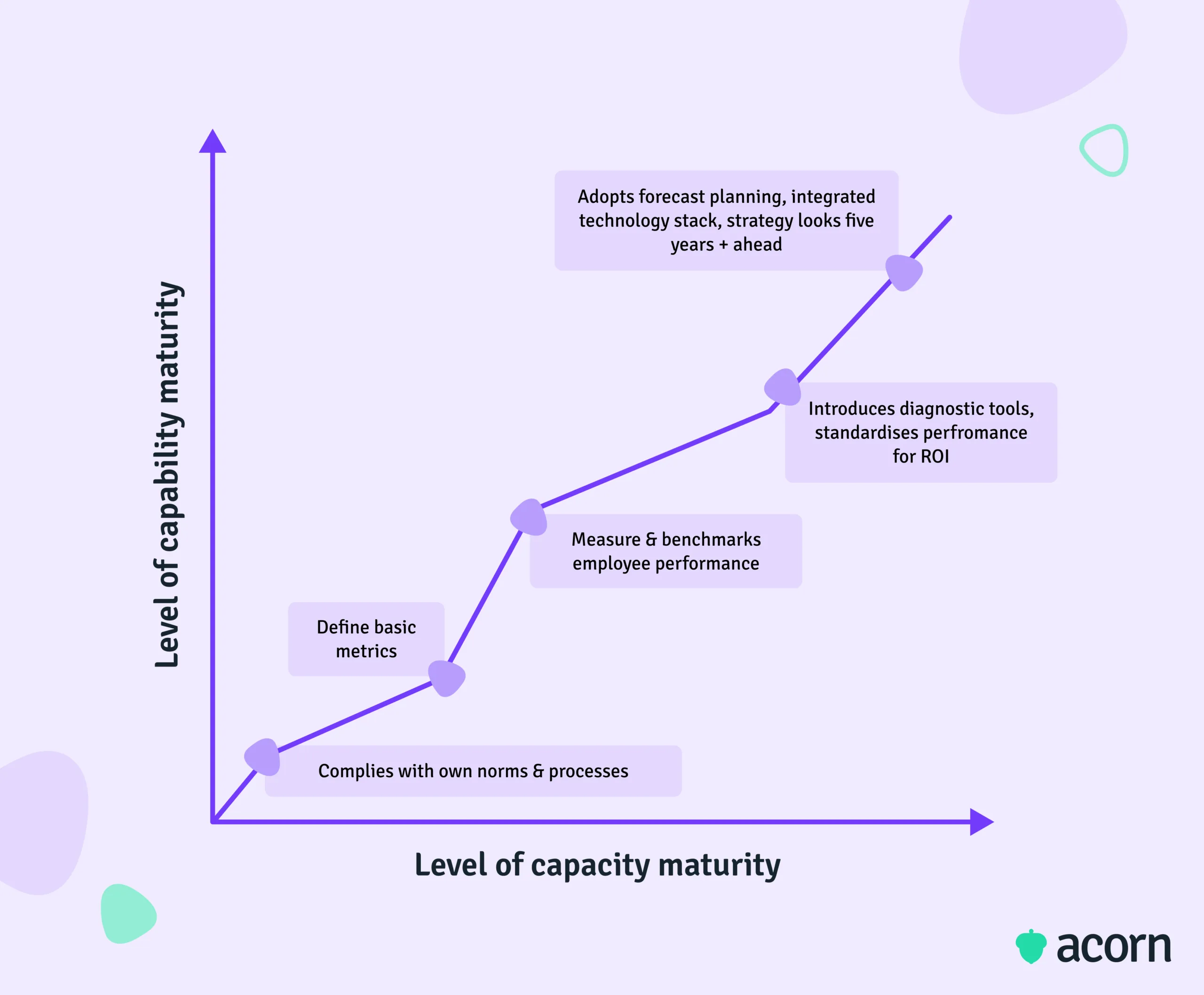What is Capacity Building and Why Should You Care About It?
Reading Time:

Lead the pack with the latest in strategic L&D every month— straight to your inbox.
SubscribeCapacity building should be aimed at developing self-sufficient momentum through a highly capable workforce.
We’ll cut the fat: There are some conflicting takes on capacity building out there. So, we’ll demystify the process and discuss how you can build the capacity for change and success in your organization in this article.
What is capacity building?
Capacity building refers to the process of developing and strengthening an organization’s ability to achieve business outcomes, often for changing circumstances like growth, expansion, or competitive advantage.
But first, what is capacity?
For clarity throughout this guide, we’ll define it as existing resources and infrastructure used by organizations to achieve their goals.
Capacity can take many forms, like:
- Intellectual, i.e., the maturity and availability of certain skills, knowledge, and behaviors amongst the workforce.
- Social, or shared culture and relationships, and networks
- Structural, such as policies, procedures, and practices
- Material, aka literal facilities, infrastructure, and equipment
- Financial, which includes the stability of your financial resources.
What is the purpose of capacity building?
If we’re talking about resources, intellectual capital, and infrastructure, then capacity building is a question of developing the organization’s ability to change.
Change doesn’t have a shelf life. Routine ways of work may be fine in times of stability, but they’ll often shatter in the face of external uncertainty. Lacking sustainable development of capacity means:
- Sudden changes will only have negative impacts, given your organization’s inability to absorb and exploit them
- You may lack efficient ways of working to begin with if the status quo is not assessed for adaptability
- Culturally, you’ll find resistance to positive or even necessary changes without systems of support
- Digital transformations will likely pass you by, decaying intellectual, structural, and material capacity.
All that is to say, you’ll lack the maturity to enact change on any level other than ad hoc, which won’t have any real measurable outcomes nor create a replicable process. (Plus, it’s wholly unhelpful for an enterprise-wide transformation such as capability building.)
That can lead to change fatigue, which only puts organizational development and HR on the back foot, taking time away from strategic work to rehabilitate their image. But for the business at large, it means strategy will be poorly enacted at the most granular level—i.e., how work gets done on the daily. You can say goodbye to competitive advantage in that case, and don’t even bother considering sustainability and resilience, either.
We built the performance learning management system (PLMS) to give organizations the information necessary to build capacity. It starts with a foundation of capabilities matched to your business strategy and then mapped to every job role, so you can be sure you have the right capabilities in the right place when you need them.
And since the PLMS shows tangible outcomes (not just compliance and learning completions), and is designed to present truly contextual learning opportunities, you can develop a learning culture to create near self-sustaining capacity within your workforce.
How to assess and build organizational capacity
If capacity building is also an exercise in building resilience, adaptability, sustainability, and more efficient ways of work, then we can make a couple of assumptions.
- Understanding capacity needs requires clear data on business challenges
- Capacity is as much a cultural and behavioural problem as it is architectural.
That brings us to a data-backed, long-term process specifically aimed at creating lasting organizational change.
- Diagnose your deficits
- Establish current capacity
- Invest in people and culture.
Diagnosing capacity deficits
Very often, the symptoms of a business problem are not indicative of the root cause. So, you need to dig deep into what is actually hurting capacity.
A capacity assessment is somewhere between an environmental scan and a needs analysis. Some guiding questions here include:
- What is driving a perceived deficit? Is it internal (e.g., talent availability) or external (economic trends)?
- What is the nature of the deficit? Workforce, organizational, structural, material?
- What are the symptoms of the deficit? Poor services, high turnover, increased attrition?
- What interventions have we already explored to fill it? Why haven’t these worked?
You’ll need to have a sound understanding of what goals the CEO has put in place for the future to truly assess the threat of a capacity deficit. Defining the business need and mission of the project will also make it easier to get buy-in from stakeholders.
Establishing capacity pools
Most capacity deficits will come back to two potential root causes.
- Availability of talent
- Knowledge systems.
We flag these because they’re also the easiest wins to make when building capacity. One helps you come from the cultural and behavioral angle, while the other asks you to think about infrastructure.
Availability of talent
The relevance and urgency of skills, behaviors, and knowledge (aka capabilities) fluctuate constantly, changing the reality of work. This impacts the strategic weight of intellectual capital throughout your organization, but also changes the accuracy of job role design in real time.
Skills databases and talent marketplaces can do some of the work by listing available skills and roles, but not always in one central location, and not always with insight into who is best prepared to step into a role. It’s why Acorn uses proficiency levels in capability assessments. These give you the granular view of someone’s readiness, even between people in similar roles. For example, you may have a cohort of entry-level HR coordinators and an open role at the next job level up. Using capability reports, you can see which of those coordinators has performed consistently at the level of proficiency needed to step into the role. Rolling assessments also gather evidence of good performance by way of manager and peer feedback, individual employees’ reflections, and business outcomes impacted.
Knowledge systems
Consider:
- If you don’t currently have centralized and widely accessible systems in place, you’re lacking on the structural, material, and organizational capacity fronts.
- A lack of understanding of what critical knowledge even is comes down to governance, affects culture, and makes it harder to create a common language around operational efficiency.
- Outdated or legacy technology acts as a slow-acting poison that impedes innovation and productivity, too.
Knowledge management systems sustain the capabilities that drive capacity. This is done by enabling the necessary collection, storage, and transfer of knowledge and skills, as well as making it freely available amongst your workforce. Think of it like a little technical assistance for capacity-building activities.
Developing your workforce
A sister process to capacity building is capability building. The two meet when we talk about developing organizational capacity to change.
In order to build and even maintain capacity, you need to be actively building capability. Think of it like a supply and demand dynamic; capability is the supply, capacity is the demand. That’s so on two fronts.
- Without the right capabilities available at the right time, your organization won’t have the fuel to power change.
- New capabilities bring about change themselves, meaning that it’s a self-fulfilling cycle to build both capacity and capability.
Say an environmental scan shows you’ve got constrained capacity in your sales department. That could be bottlenecks and low close rates. A capacity diagnosis uncovers that it’s a talent and resource issue of not enough of the right roles.

That gives you two angles from which to attack:
- Job role and team design
- Individual capability.
The former is a business architecture task done in collaboration with team leaders, the latter one for L&D. Both can be linked back to training and development opportunities designed to bridge the capability gaps impacting capacity. Think product knowledge, positive behaviors, and knowledge systems that help reps execute their KPIs.
Key takeaways
Any capacity building strategy should start at the institutional level to consider business needs and challenges. From there, you want to look to potential areas of impact like workforce and strategic planning, L&D, leadership, and knowledge systems.
Any capacity building initiatives you undertake should be coupled with developing skills, knowledge, and behaviors to an optimal level of performance. This is so capacity isn’t reliant on a number of people in your organization or external support—rather, the point is that your organization has self-sufficient internal momentum.